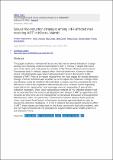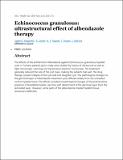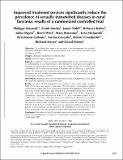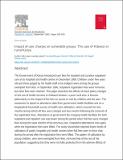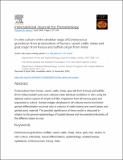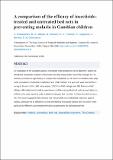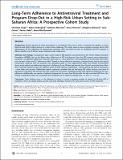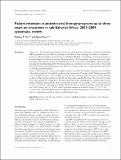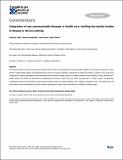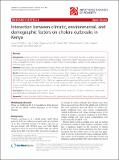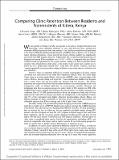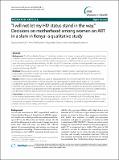General - GEN: Recent submissions
Now showing items 241-260 of 367
-
Sexual and Reproductive Health among Primary and Secondary School Pupils in Mwanza, Tanzania: Need for Intervention
(Taylor and Francis, 2010-05-27)A cross-sectional questionnaire survey was conducted among 892 randomly selected pupils, aged 12 and above, attending 18 primary schools (PS) and five secondary schools (SS) in four communities of Mwanza Region in Tanzania. ... -
Sexual and Reproductive Health among Primary and Secondary School Pupils in Mwanza, Tanzania: Need for Intervention
(AIDS Care, 1998)A cross-sectional questionnaire survey was conducted among 892 randomly selected pupils, aged 12 and above, attending 18 primary schools (PS) and five secondary schools (SS) in four communities of Mwanza Region in Tanzania. ... -
Hydatid disease in the Turkana district of Kenya, IV. The prevalence of Echinococcus granulosus infections in dogs, and observations on the role of the dog in the lifestyle of the Turkana.
(Liverpool of Tropical Medicine, 4/14/1983)The prevalence of Echinococcus granulosus in dogs in the Turkana District of Kenya was 39.4% of 695 examined. Of these, 98 (35.8%) had heavy Echinococcus worm burdens (10(3)-5 X 10(4) ), while 54 (19.7%) and 122 (44.5%) ... -
Echinococcus granulosus: Ultrastructural Effect of Albendazole Therapy
(African Journal of Health Sciences, 1994-11)The effects of the anthelmintic Albendazole against Echinococcus granulosus hydatid cysts in Turkana patients given orally were studied by means of ultrasound as well as light microscopy, scanning and transmission electron ... -
Improved Treatment Services Significantly Reduce the Prevalence of Sexually Transmitted Diseases in Rural Tanzania: Result of a Randomized Controlled Trial
(AIDS, 12/11/1997)Objective: To evaluate the impact of improved case management for sexually transmitted diseases (STD) at the primary health care level on the incidence and prevalence of STD. Design: Community-randomized controlled ... -
Simplified PCR for Detection of Haemophilus ducreyi and Diagnosis of Chancroid
(1995-04)A simplified PCR was developed for detection of Haemophilus ducreyi in samples from chancroid patients. The strategy included a straightforward chloroform extraction sample preparation method, a one-tube nested PCR to ... -
Impact of User Charges on Vulnerable Groups: The Case of Kibwezi in Rural Kenya
(Elsevier, 1995-09)The Government of Kenya introduced user fees for inpatient and curative outpatient care at its hospitals and health centres in December 1989. Children under five years old and those judged by the health staff to be indigent ... -
A Single Dose of Intramuscular Sulfadoxine-Pyrimethamine as an Adjunct to Quinine in the Treatment of Severe Malaria: Pharmacokinetics and Efficacy
(Oxford University Press, 4/1/1983)It has been suggested that sulfadoxine-pyrimethamine (SDPM) may be useful in the treatment of severe malaria since it could enhance the killing of parasites by quinine (QN) and it can be given as a single intramuscular ... -
Hydatid Disease in the Turkana District of Kenya. III. The Significance of Wild Animals in the Transmission of Echinococcus granulosus, with Particular Reference to Turkana and Masailand in Kenya
(Pathogens and Global Health - Annals of Tropical Medicine and Parasitology, 1983-03)The results are given of a study on the role of wildlife in the transmission of Echinococcus granulosus in the Turkana and Narok Districts of Kenya. A total of 76 wild carnivores belonging to three separate species was ... -
Validation of a WHO Algorithm with Risk Assessment for the Clinical Management of Vaginal Discharge in Mwanza, Tanzania
(Sexually Transmitted Infections, 1998-07)Objectives: (i) To determine the microbial aetiologies of vaginal discharge in STD clinic and antenatal clinic (ANC) attenders; (ii) to evaluate the performance and costs of a new WHO algorithm for the detection of gonococcal ... -
A Comparative Study of Echinococcus granulosus from Human and Animal Hosts in Kenya Using Isoelectric Focusing and Isoenzyme Analysis
(12/1/1982)The soluble enzyme extracts from protoscoleces obtained from hydatid cysts of human, camel, cattle, sheep and goat origin were compared on the basis of their isoenzyme patterns for GPI and PGM using isoelectric focusing. ... -
The Identification of Eggs of Echinococcus by Immunofluorescence Using a Specific Anti-oncospheral Monoclonal antibody
(The American journal of tropical medicine and hygiene, 1/1/1986)A relatively simple and specific test has been developed to distinguish eggs of Echinococcus from those of other morphologically identical taeniid species. A specific anti-Echinococcus oncosphere monoclonal antibody was ... -
In vitro culture of the strobilar stage of Echinococcus granulosus from protoscoleces of human, camel, cattle, sheep and goat origin from Kenya and buffalo origin from India
(Elsevier, 1985-04)Protoscoleces from human, camel, cattle, sheep, goat (all from Kenya) and buffalo (from India) hydatid cysts were cultured under identical conditions in vitro using the diphasic culture system of Smyth (1979b). Organisms ... -
A Compariosn of efficacy of insecticide-Treated and Untreated Bednets in Preventing Malaria in Gambian Children
(Oxford University Press, 11/1/1995)An evaluation of the Gambian national insecticide impregnated bed net programme, which has introduced insecticide treatment of bed nets into all primary health care (PHC) villages in The Gambia, provided an opportunity to ... -
Long-Term Adherence to Antiretroviral Treatment and Program Drop-out in a High-Risk Urban Setting in Sub-Saharan Africa: A Prospective Cohort Study
(PLoS ONE, 10/25/2010)Background: Seventy percent of urban populations in sub-Saharan Africa live in slums. Sustaining HIV patients in these high-risk and highly mobile settings is a major future challenge. This study seeks to assess program ... -
Patient Retention in Antiretroviral Therapy Programs up to Three Years on Treatment in Sub-Saharan Africa, 2007-2009: Systematic Review: Patient Retention in Antiretroviral Therapy Programs
(Blackwell Publishing Ltd., 2010-06)Objectives To estimate the proportion of all-cause adult patient attrition from antiretroviral therapy (ART) programs in service delivery settings in sub-Saharan Africa through 36 months on treatment. Methods We ... -
Integration of Non-Communicable Diseases in Health Care: Tackling the Double Burden of Disease in African Settings
(Pan African Medical Journal and African Field Epidemiology Network (AFENET), 7/5/2014)Sub-Saharan African countries now face the double burden of Non Communicable and Communicable Diseases. This situation represents a major threat to fragile health systems and emphasises the need for innovative integrative ... -
Interaction Between Climatic, Environmental, and Demographic Factors on Cholera Outbreaks in Kenya
(BioMed Central, 10/1/2014)Background: Cholera remains an important public health concern in developing countries including Kenya where 11,769 cases and 274 deaths were reported in 2009 according to the World Health Organization (WHO). This ... -
Comparing Clinic Retention Between Residents and Nonresidents of Kibera, Kenya
(Lippincott Williams & Wilkins, 3/1/2010)We are grateful to Chung et al who, in response to our article, brought forward several interesting issues regarding retention in care and drop-out from antiretroviral treatment (ART) programs in urban slum settings.1 Our ... -
“I will not let my HIV status stand in the way." Decisions on motherhood among women on ART in a slum in Kenya a qualitative study
(BioMed Central, 4/28/2010)Background The African Medical Research Foundation antiretroviral therapy program at the community health centre in Kibera counsels women to wait with pregnancy until they reach the acceptable level of 350 cells/ml CD4 ...

